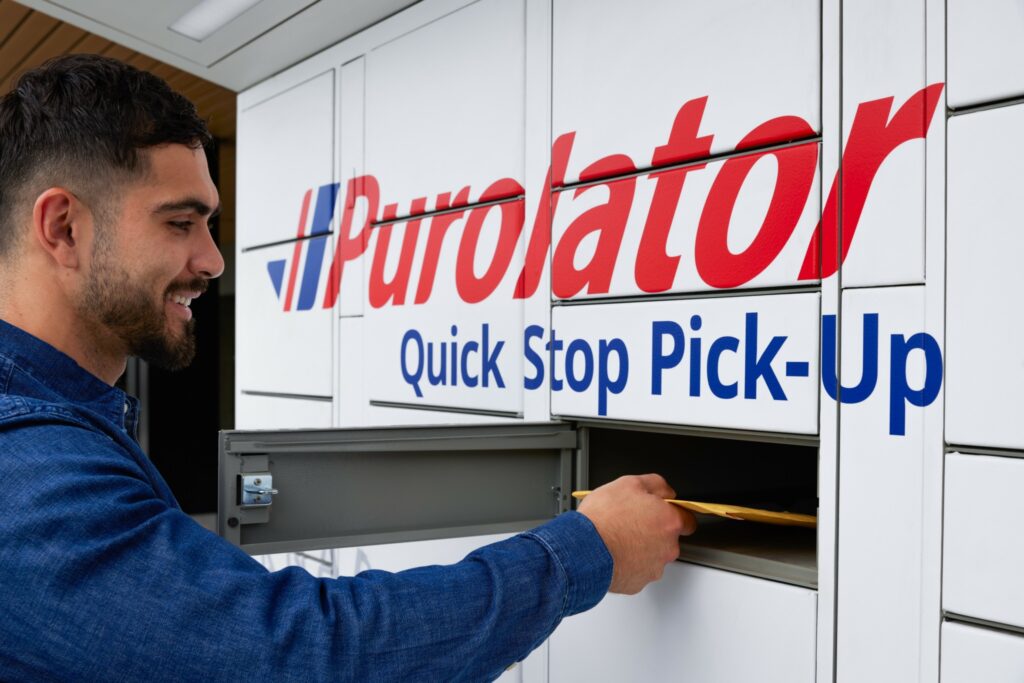Parcel pickup lockers help streamline final mile for couriers
The concept of centralized parcel pickup lockers is growing as couriers across the industry use this method to improve final-mile deliveries, save costs and improve customers’ shopping experience. There are sustainability elements to it, too.
Canada’s Purolator, for example, launched the pilot version of the Quick Stop Pick-up parcel lockers in 2018, and the manufacturing started in 2019, in partnership with Parcel Pending, says Laurie Weston, Purolator’s general manager of e-commerce.

Currently, there are about 54 Purolator Quick Stop Pick-up lockers across Canada. Weston says this method proves to be efficient for the courier and customer, alike.
By not having to deliver to the door of a residential home or by avoiding traffic to get to condominiums downtown, drivers save fuel and time, allowing them to optimize routes, make more stops and cover a larger area. This helps maintain a consistent workload and reduces the need for additional couriers.
“The last-mile delivery cost to a residential home, obviously, costs a bit more than, let’s say, a business,” Weston says. By consolidating pickups and drop-offs at designated locations like lockers, couriers can reduce these costs.
With a large number of online retail customers using the centralized lockers, which were initially designed to facilitate last-mile deliveries, the lockers can also play a role in the first mile of deliveries, Weston says.
She explains that customers often return delivered items and send them back to retailers.
First- and final-mile opportunities
“Let’s say you bought something from Zara and you want to return it. You have the return label, you go to the locker, scan your barcode on your return label, locker pops open and you place it in,” explained Weston, adding the big advantage of the lockers is 24/7 accessibility. Because they are placed outside, they are also weatherproof. Adding this and other additional features to the lockers, like extreme temperature resistance, helps a business to stand out from the competition.
Weston believes the centralized lockers culture will keep growing in the final-mile delivery industry.
For example, other couriers like Amazon also have lockers in Canada. And while there are no UPS lockers here yet, the company’s Access Point lockers are available in the U.S. Parcel pick-up lockers have been common in Europe for quite some time, too.
“But because Canada is so different and so large geographically, where the lockers are going to be placed is key to success,” Weston says.
High-density urban areas are one example.
By placing lockers in busy urban areas of Toronto, Montreal or Vancouver, Purolator has its lockers’ occupancy rate at 72%. However, Weston believes that to achieve a 100% occupancy rate, multi-carrier use lockers are the best bet. While they do not have to be located in a dense area, they allow for accessibility and occupancy. For this reason, they are already popular in the U.K., she says.
But the company is planning on expanding beyond metropolitan high-density areas, into secondary cities with high delivery volumes. Weston adds that in the future, Purolator will be test the lockers in remote locations, including Indigenous communities.
Another advantage for both carrier and consumer is the increased safety of delivered parcels. With high-value goods, for example, most of the customers prefer picking them up themselves.
“Because when we place a parcel in the locker, we send a QR code or a four-digit code specifically for you. No one else can get it.”
Stopping porch pirates
Such a system prevents thefts, while ‘porch pirates’ thrive on parcels left on doorsteps.
There are added sustainability benefits to centralized lockers as well.
By reducing distance traveled, couriers reduce emissions, helping fulfil the company’s environmental initiatives. Another last-mile delivery offering that Purolator has recently launched is Urban Quick Stops.
In partnership with the University of Toronto and the Toronto Parking Authority, particularly at Young and Spadina, the company set up 40-foot shipping containers that serve as distribution hubs for retail stores.
“When we talk about the last mile, one of the things we want to do is to really remove big vehicles out of the downtown core, remove the congestion, remove the traffic,” Weston says.
She explains these Urban Quick Stops containers function as micro-distribution hubs. All the shipments addressed to the same postal code or university campus are stored there. Trucks bring in the shipments in the morning, and couriers distribute them using e-bikes that are also stored inside the container.
Have your say
This is a moderated forum. Comments will no longer be published unless they are accompanied by a first and last name and a verifiable email address. (Today's Trucking will not publish or share the email address.) Profane language and content deemed to be libelous, racist, or threatening in nature will not be published under any circumstances.
I like this idea… Especially the ebike delivery part.